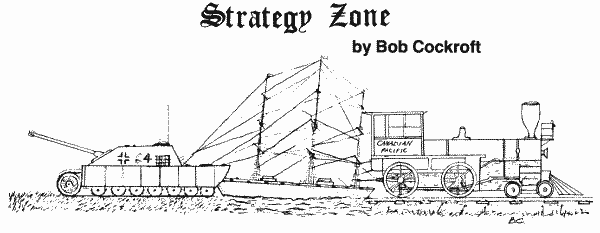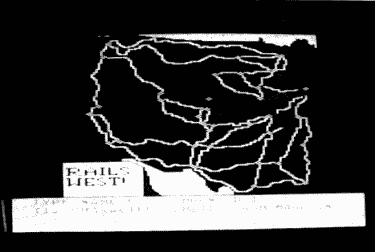
By combining various aspects of the business environment with numerous strategic options, Rails West recreates the era of the frontier railroads in an interesting way. Being the best business strategy game I have yet played, it provides excitement even for the person who had not in the past enjoyed strategy games.
Rails West is a game in which the players are 19th century, western American railroad barons who must strategically invest, and compete with each other in order to maximize their wealth. Buying stocks and bonds, these barons seek control of desirable railroads. However, poor economic conditions and actions of competitors may destroy even the best planned strategies. With corporate take-overs, bankruptcies, loan defaults and other business occurrences, a realistic simulation is created.
Because of good strategical design, Rail West is really three games in one. In one sense, it is a game of corporate power struggles. Each player competes with one another for control of the most profitable railroads. Usually not having the needed financial resources, players are able to buy only a small percentage of a companY's stock. Although being enough to control the company's decisions, it leaves the present controller open to take-overs from other players. In addition, should the price of the company's stock fall, making the take-over cost less expensive, the current controller's position becomes even more precarious. Although the money from the issuing of stock is needed for expansion, in order to avoid lower prices, the controller must not flood the market with the company's stock.

In another sense, Rails West is a corporate management game. Controllers of companies could attempt to increase corporate profits and dividend yields in an attempt to accumulate personal wealth. Although issuing bonds provides funds for expansion, their interest expense reduces income. On the other hand, the issuing of common stock erodes its market price and reduces personal control. This conflict between debt and equity adds a needed dimension to the game.
In yet another sense, Rails West is a stock and bond investment game. Players do not need to control corporations. If they wish, players could just speculate on stock and bond prices. Growing companies with high dividend policies could be good buys for the prudent investor. In addition, buying securities during a depression when their prices are low and selling them during a boom when they are higher, investors could make a considerable amount of money.
This game provides for up to four human and four computer controlled players. This capability makes this game much more flexible. In addition, skill levels are created so that there is a challenging game for the more experienced player.
Perhaps one of the interesting aspects of this game is its complexity. A player has many interesting options. This promotes numerous strategies for achieving the same goal. There is no one best tactic, only a handful of methods that may or may not work. As a result, every game is different. When using the option that randomly sets-up the game, completely new strategies must be devised in order to succeed. Because of its complexity, this game is difficult to master. After spending many hours playing it, I have not yet developed a strategy that ensures a high degree of success.
Unfortunately, Rails West is not without some weaknesses. Although the game has an interesting presentation, it is a little slow. The computer controlled players' seem to take too long to react. The human player wastes time waiting for all the computer controlled players actions to be displayed and performed. However, the computer responses are not excessively slow and so do not greatly detract from the game.
Although this game has an interesting map of the rail system in the western the United States, the process used to identify an individual rail line is poor. A player needs to run through a rather long list of potential rail routes before obtaining the one he wants. A more creative indentification system is needed so that rail lines can be indentified more quickly. Fortunately, this problem affects only a minor part of the game.
Rails West is a success. It does a fine job of recreating the finances of the frontier railroads. The game's many strengths far outweigh its weaknesses. But probably this game's best aspect is its ability to foster economic warfare between players. Rails West is an unique, exciting game and one that I would recommend.
Carrier Force is a game of naval air power during the Pacific campaigns of World War II. Recreating four major battles(Santa Cruz, Midway, Solomons and Coral Sea), this game attempts to depict the scenarios and strategies used by both American and Japanese naval forces. This game reveals an insight into the tactics of carrier warfare. A player obtains an understanding of how some major sea battles of World War II were won and lost.
Carrier Force's greatest strength is it complexity. There are many details that make this game quite interesting. Having played the board game Midway a number of times, I found the Carrier Forces version a refreshing refinement. There are many more types of aircraft, each having their own characteristics. Varying in maximum speed, endurance, bomber accuracy and combat capabilities, aircraft must be carefully chosen for each mission. In addition, there is also a good selection of ship types to choose from. Unlike the board game, this version has added a number of naval vessels that seem to add a needed dimension. Although not significant in themselves, destroyers, tankers, submarines, minesweepers and minelayers, can be used to assist larger craft. Once having located an enemy fleet, it is not always easy for one to direct the attacking aircraft to it. A change in the fleet's heading or poor weather conditions, can make detection difficult. An attacking force can only be directed to the enemy fleet's last reported position. Instinct and luck must be used from there on. This aspect creates a realistic uncertainty that does not exist in any board game version I have played.
Carrier Force is an exciting and unique game. It promotes strategies that are not found in most war games. Unlike typical land force tactics, this is a game of naval hide and seek. Each naval force hides while seeking the enemy. In addition, a fighter umbrella over the carrier fleets must be maintained for protection against surprise attacks or enemy reconnaisance. The option that provides random set-ups enables numerous battles to develop from the same historical situation. This is not a game that once used can be thrown away. Everytime this game is played, It reveals a new undiscovered aspect of carrier warfare.
This game does have some weaknesses that detract somewhat from its strengths. The graphics are poorer than what one might expect from a game of such caliber. Although this is only a visual shortcoming that does not hamper play, it is something of at least minor concern. The scrolling on the map display is coarse and must be directed by the numbers on the keyboard. In addition, it is not clear from the display which number corresponds with the desired direction. But Carrier Force's biggest weakness is its lack of speed. The game takes too long for it to determine the Japanese operations. In addition, the human player is too often forced to press "C" to continue the game where the computer should do it automatically.
Although being slow, Carrier Force is an excellent strategic game. It provides excitement, tactics and detail not found in most wargames. Its scenarios are enough to satisfy even the most sophisticated wargamer. For those who do not mind waiting for the computer to respond, Carrier Force will bring hours of enjoyment.